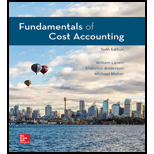
Activity-Based Costing of Suppliers
Kinnear Plastics manufactures various components for the aircraft and marine industry. Kinnear buys plastic from two vendors: Tappan Corporation and Hill Enterprises. Kinnear chooses the vendor based on price. Once the plastic is received, it is inspected to ensure that it is suitable for production. Plastic that is deemed unsuitable is disposed of.
The controller at Kinnear collected the following information on purchases for the past year:

The purchasing manager has just received bids on an order for 150 tons of plastic from both Tappan and Hill. Tappan bid $1,482 and Hill bid $1,463 per ton.
Required
Assume that the average quality, measured by the amounts discarded from the two companies, will continue as in the past. Which supplier would you recommend that the purchasing manager select? Explain.
Want to see the full answer?
Check out a sample textbook solution
Chapter 10 Solutions
Fundamentals of Cost Accounting
- Accounting Question: Analyze the factors that contribute to the ongoing evolution of accounting standards and frameworks. How do changes in the business environment, technological advancements, and shifting stakeholder expectations drive the need for periodic updates and revisions to established accounting principles and practices? Answerarrow_forwardThe gross margin for October is?arrow_forwardThe analysts projection of total owners equity should be closestarrow_forward
- Cost of goods sold on the schedule of cost of goods sold?arrow_forwardAn analyst has projected that a company will have assets of $9,000 at year-end and liabilities of $7,300. The analyst's projection of total owners' equity should be closest to: A. $1700 B. $2,000 C. $3,200arrow_forwardGeneral Accountingarrow_forward
 Managerial AccountingAccountingISBN:9781337912020Author:Carl Warren, Ph.d. Cma William B. TaylerPublisher:South-Western College Pub
Managerial AccountingAccountingISBN:9781337912020Author:Carl Warren, Ph.d. Cma William B. TaylerPublisher:South-Western College Pub Cornerstones of Cost Management (Cornerstones Ser...AccountingISBN:9781305970663Author:Don R. Hansen, Maryanne M. MowenPublisher:Cengage Learning
Cornerstones of Cost Management (Cornerstones Ser...AccountingISBN:9781305970663Author:Don R. Hansen, Maryanne M. MowenPublisher:Cengage Learning Excel Applications for Accounting PrinciplesAccountingISBN:9781111581565Author:Gaylord N. SmithPublisher:Cengage Learning
Excel Applications for Accounting PrinciplesAccountingISBN:9781111581565Author:Gaylord N. SmithPublisher:Cengage Learning Managerial Accounting: The Cornerstone of Busines...AccountingISBN:9781337115773Author:Maryanne M. Mowen, Don R. Hansen, Dan L. HeitgerPublisher:Cengage Learning
Managerial Accounting: The Cornerstone of Busines...AccountingISBN:9781337115773Author:Maryanne M. Mowen, Don R. Hansen, Dan L. HeitgerPublisher:Cengage Learning



